BEA111 Principles of Economics Assignment: Climate Change and Products
VerifiedAdded on 2022/11/24
|6
|774
|55
Report
AI Summary
This economics report, prepared for a ministerial briefing, examines the impact of climate change on the Australian economy, specifically focusing on the effects on wheat and milk. The report explores the microeconomic impacts, such as changes in demand and supply, leading to price fluctuations and potential scarcity. It also delves into the macroeconomic consequences, including demand-pull inflation, unemployment, and reduced economic growth due to supply shortages. The analysis considers the welfare of both producers and consumers, highlighting the need for strategies to mitigate the negative impacts of climate change. The report concludes with a call for action from various stakeholders to address these challenges and develop effective solutions.
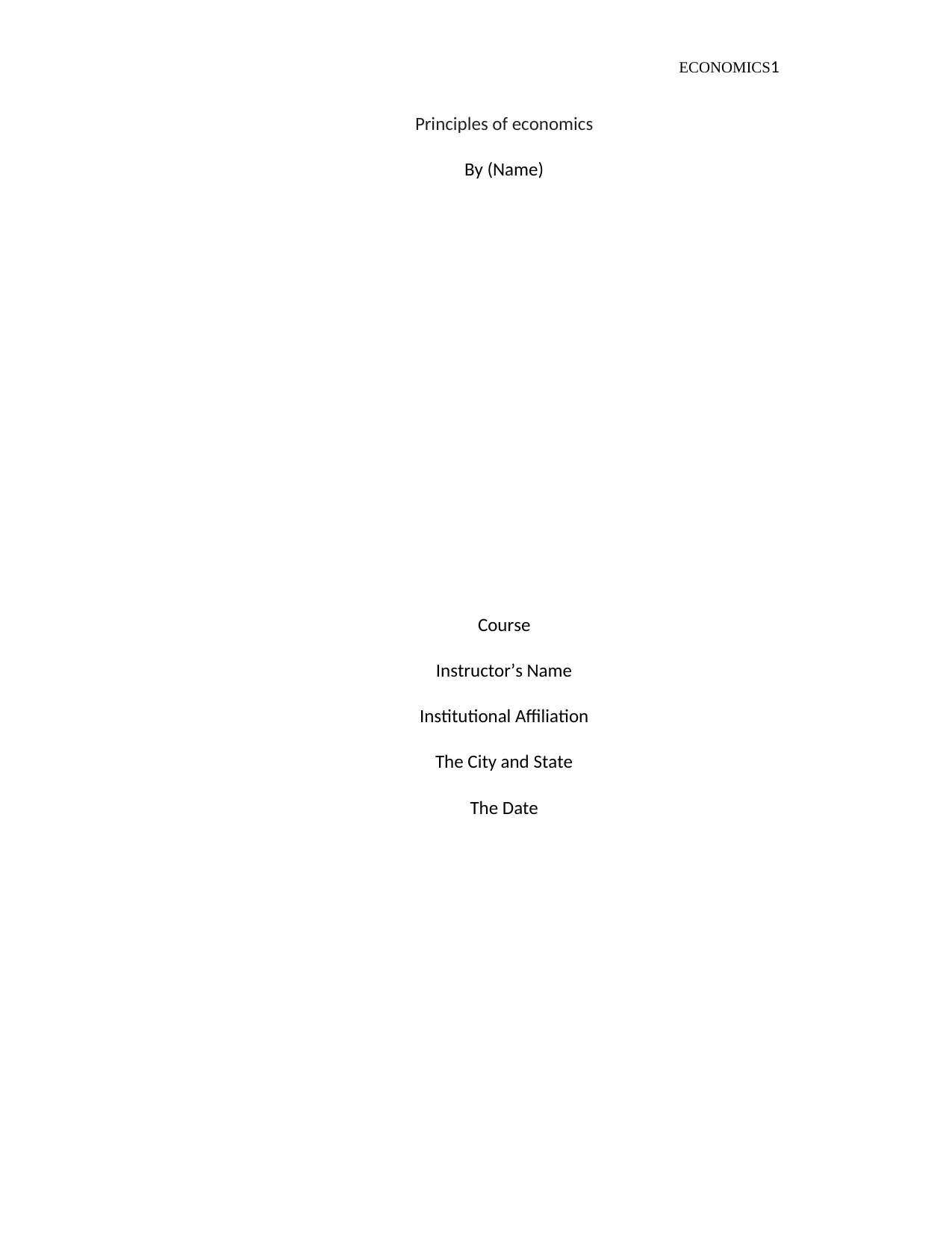
ECONOMICS1
Principles of economics
By (Name)
Course
Instructor’s Name
Institutional Affiliation
The City and State
The Date
Principles of economics
By (Name)
Course
Instructor’s Name
Institutional Affiliation
The City and State
The Date
Paraphrase This Document
Need a fresh take? Get an instant paraphrase of this document with our AI Paraphraser
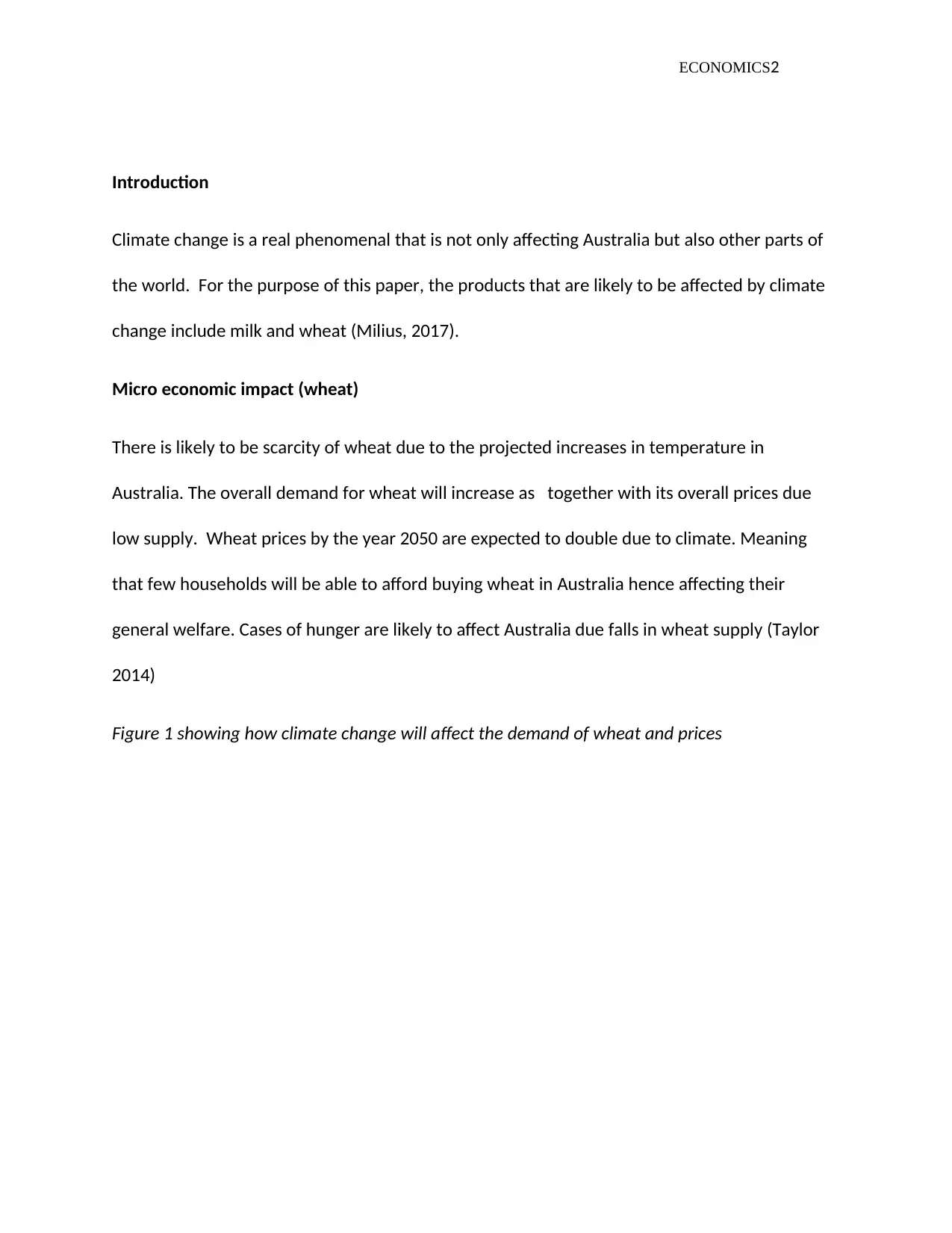
ECONOMICS2
Introduction
Climate change is a real phenomenal that is not only affecting Australia but also other parts of
the world. For the purpose of this paper, the products that are likely to be affected by climate
change include milk and wheat (Milius, 2017).
Micro economic impact (wheat)
There is likely to be scarcity of wheat due to the projected increases in temperature in
Australia. The overall demand for wheat will increase as together with its overall prices due
low supply. Wheat prices by the year 2050 are expected to double due to climate. Meaning
that few households will be able to afford buying wheat in Australia hence affecting their
general welfare. Cases of hunger are likely to affect Australia due falls in wheat supply (Taylor
2014)
Figure 1 showing how climate change will affect the demand of wheat and prices
Introduction
Climate change is a real phenomenal that is not only affecting Australia but also other parts of
the world. For the purpose of this paper, the products that are likely to be affected by climate
change include milk and wheat (Milius, 2017).
Micro economic impact (wheat)
There is likely to be scarcity of wheat due to the projected increases in temperature in
Australia. The overall demand for wheat will increase as together with its overall prices due
low supply. Wheat prices by the year 2050 are expected to double due to climate. Meaning
that few households will be able to afford buying wheat in Australia hence affecting their
general welfare. Cases of hunger are likely to affect Australia due falls in wheat supply (Taylor
2014)
Figure 1 showing how climate change will affect the demand of wheat and prices
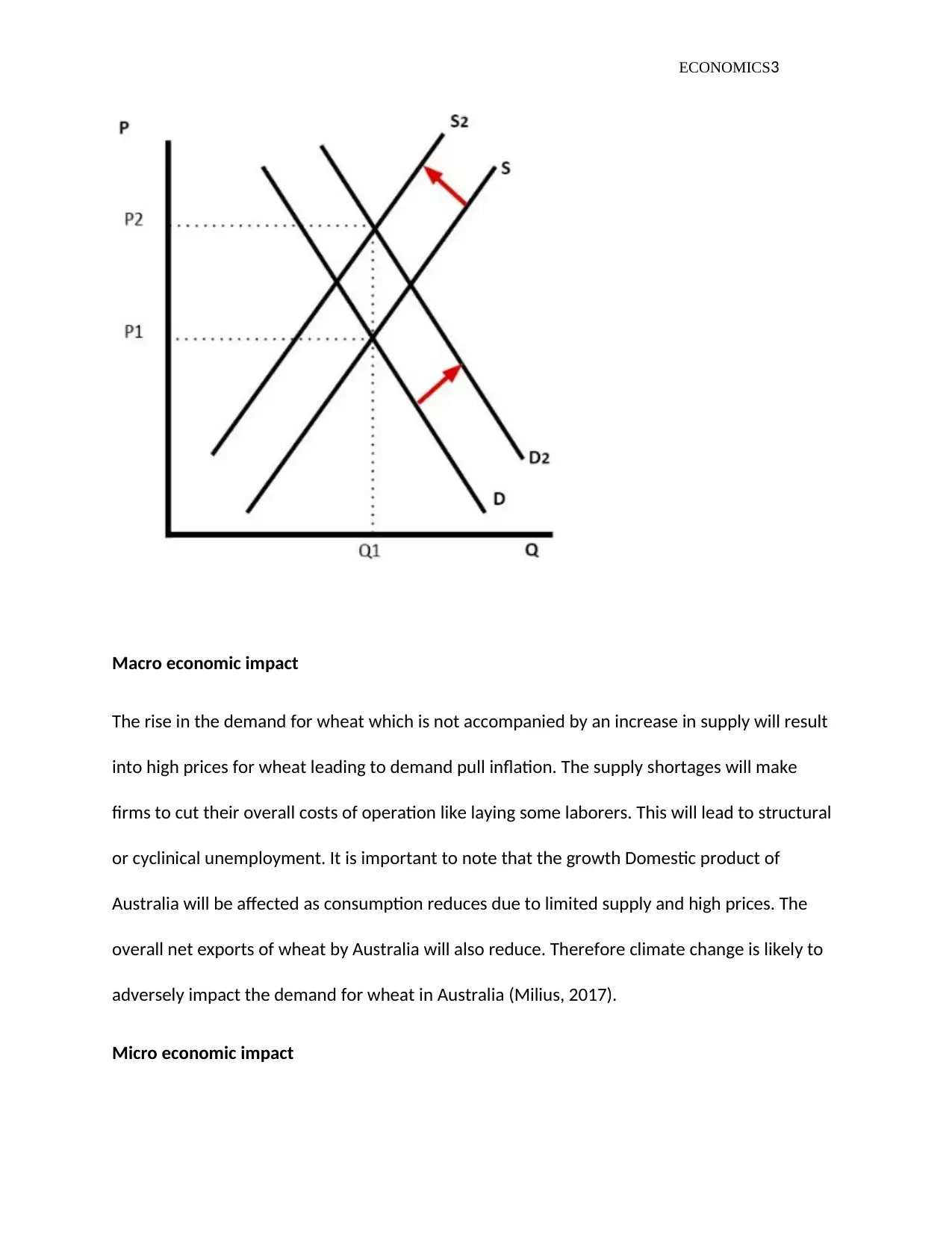
ECONOMICS3
Macro economic impact
The rise in the demand for wheat which is not accompanied by an increase in supply will result
into high prices for wheat leading to demand pull inflation. The supply shortages will make
firms to cut their overall costs of operation like laying some laborers. This will lead to structural
or cyclinical unemployment. It is important to note that the growth Domestic product of
Australia will be affected as consumption reduces due to limited supply and high prices. The
overall net exports of wheat by Australia will also reduce. Therefore climate change is likely to
adversely impact the demand for wheat in Australia (Milius, 2017).
Micro economic impact
Macro economic impact
The rise in the demand for wheat which is not accompanied by an increase in supply will result
into high prices for wheat leading to demand pull inflation. The supply shortages will make
firms to cut their overall costs of operation like laying some laborers. This will lead to structural
or cyclinical unemployment. It is important to note that the growth Domestic product of
Australia will be affected as consumption reduces due to limited supply and high prices. The
overall net exports of wheat by Australia will also reduce. Therefore climate change is likely to
adversely impact the demand for wheat in Australia (Milius, 2017).
Micro economic impact
⊘ This is a preview!⊘
Do you want full access?
Subscribe today to unlock all pages.

Trusted by 1+ million students worldwide
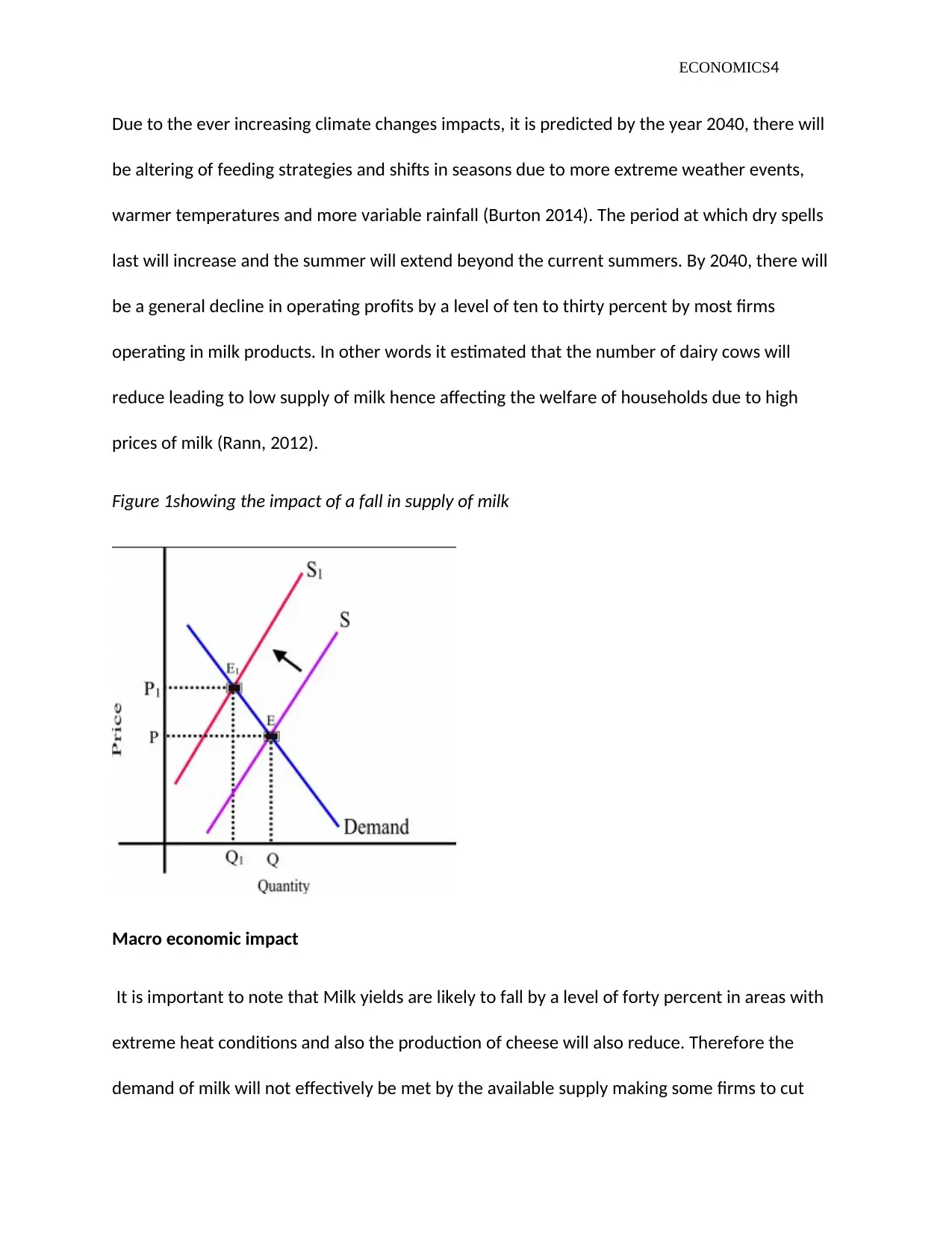
ECONOMICS4
Due to the ever increasing climate changes impacts, it is predicted by the year 2040, there will
be altering of feeding strategies and shifts in seasons due to more extreme weather events,
warmer temperatures and more variable rainfall (Burton 2014). The period at which dry spells
last will increase and the summer will extend beyond the current summers. By 2040, there will
be a general decline in operating profits by a level of ten to thirty percent by most firms
operating in milk products. In other words it estimated that the number of dairy cows will
reduce leading to low supply of milk hence affecting the welfare of households due to high
prices of milk (Rann, 2012).
Figure 1showing the impact of a fall in supply of milk
Macro economic impact
It is important to note that Milk yields are likely to fall by a level of forty percent in areas with
extreme heat conditions and also the production of cheese will also reduce. Therefore the
demand of milk will not effectively be met by the available supply making some firms to cut
Due to the ever increasing climate changes impacts, it is predicted by the year 2040, there will
be altering of feeding strategies and shifts in seasons due to more extreme weather events,
warmer temperatures and more variable rainfall (Burton 2014). The period at which dry spells
last will increase and the summer will extend beyond the current summers. By 2040, there will
be a general decline in operating profits by a level of ten to thirty percent by most firms
operating in milk products. In other words it estimated that the number of dairy cows will
reduce leading to low supply of milk hence affecting the welfare of households due to high
prices of milk (Rann, 2012).
Figure 1showing the impact of a fall in supply of milk
Macro economic impact
It is important to note that Milk yields are likely to fall by a level of forty percent in areas with
extreme heat conditions and also the production of cheese will also reduce. Therefore the
demand of milk will not effectively be met by the available supply making some firms to cut
Paraphrase This Document
Need a fresh take? Get an instant paraphrase of this document with our AI Paraphraser
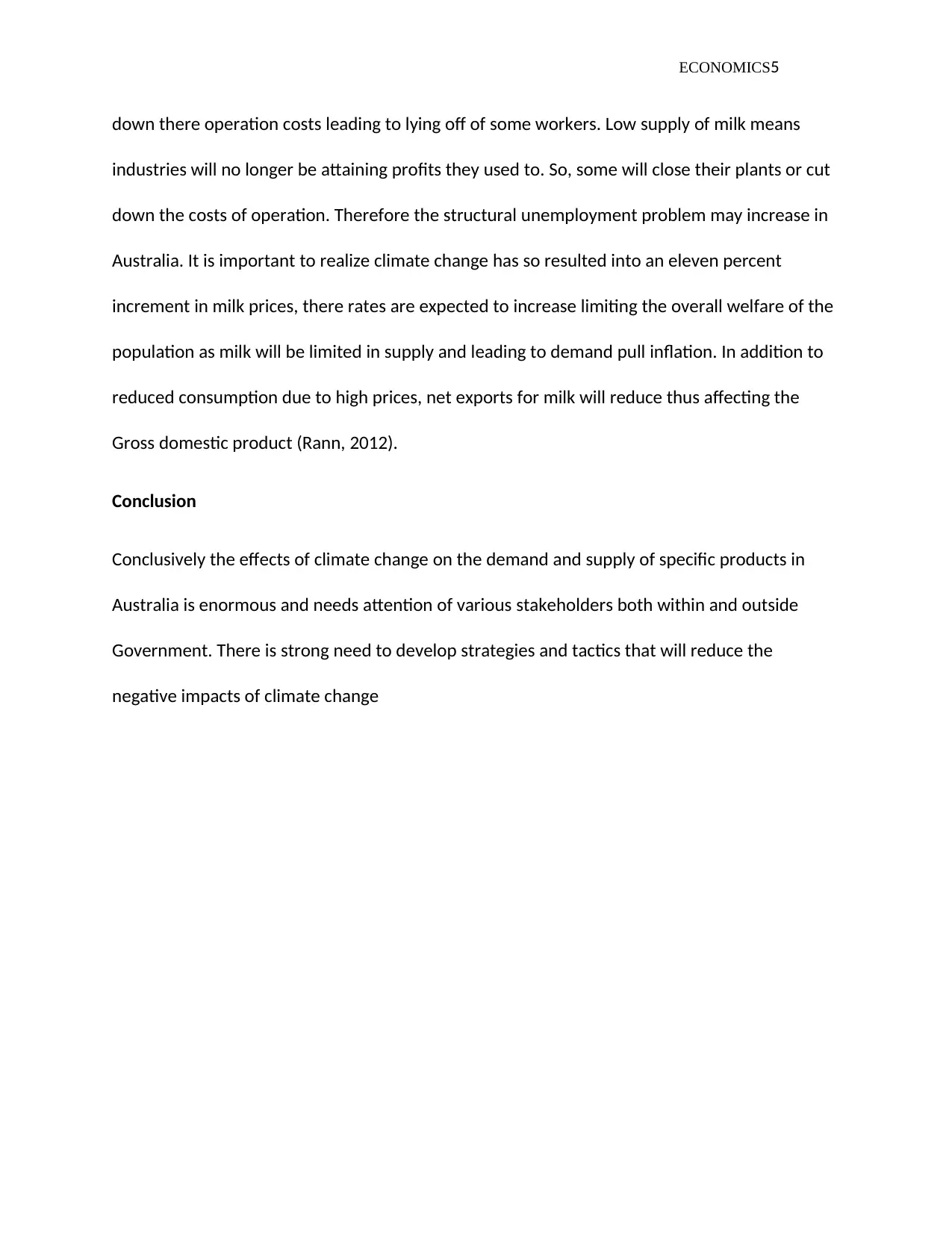
ECONOMICS5
down there operation costs leading to lying off of some workers. Low supply of milk means
industries will no longer be attaining profits they used to. So, some will close their plants or cut
down the costs of operation. Therefore the structural unemployment problem may increase in
Australia. It is important to realize climate change has so resulted into an eleven percent
increment in milk prices, there rates are expected to increase limiting the overall welfare of the
population as milk will be limited in supply and leading to demand pull inflation. In addition to
reduced consumption due to high prices, net exports for milk will reduce thus affecting the
Gross domestic product (Rann, 2012).
Conclusion
Conclusively the effects of climate change on the demand and supply of specific products in
Australia is enormous and needs attention of various stakeholders both within and outside
Government. There is strong need to develop strategies and tactics that will reduce the
negative impacts of climate change
down there operation costs leading to lying off of some workers. Low supply of milk means
industries will no longer be attaining profits they used to. So, some will close their plants or cut
down the costs of operation. Therefore the structural unemployment problem may increase in
Australia. It is important to realize climate change has so resulted into an eleven percent
increment in milk prices, there rates are expected to increase limiting the overall welfare of the
population as milk will be limited in supply and leading to demand pull inflation. In addition to
reduced consumption due to high prices, net exports for milk will reduce thus affecting the
Gross domestic product (Rann, 2012).
Conclusion
Conclusively the effects of climate change on the demand and supply of specific products in
Australia is enormous and needs attention of various stakeholders both within and outside
Government. There is strong need to develop strategies and tactics that will reduce the
negative impacts of climate change
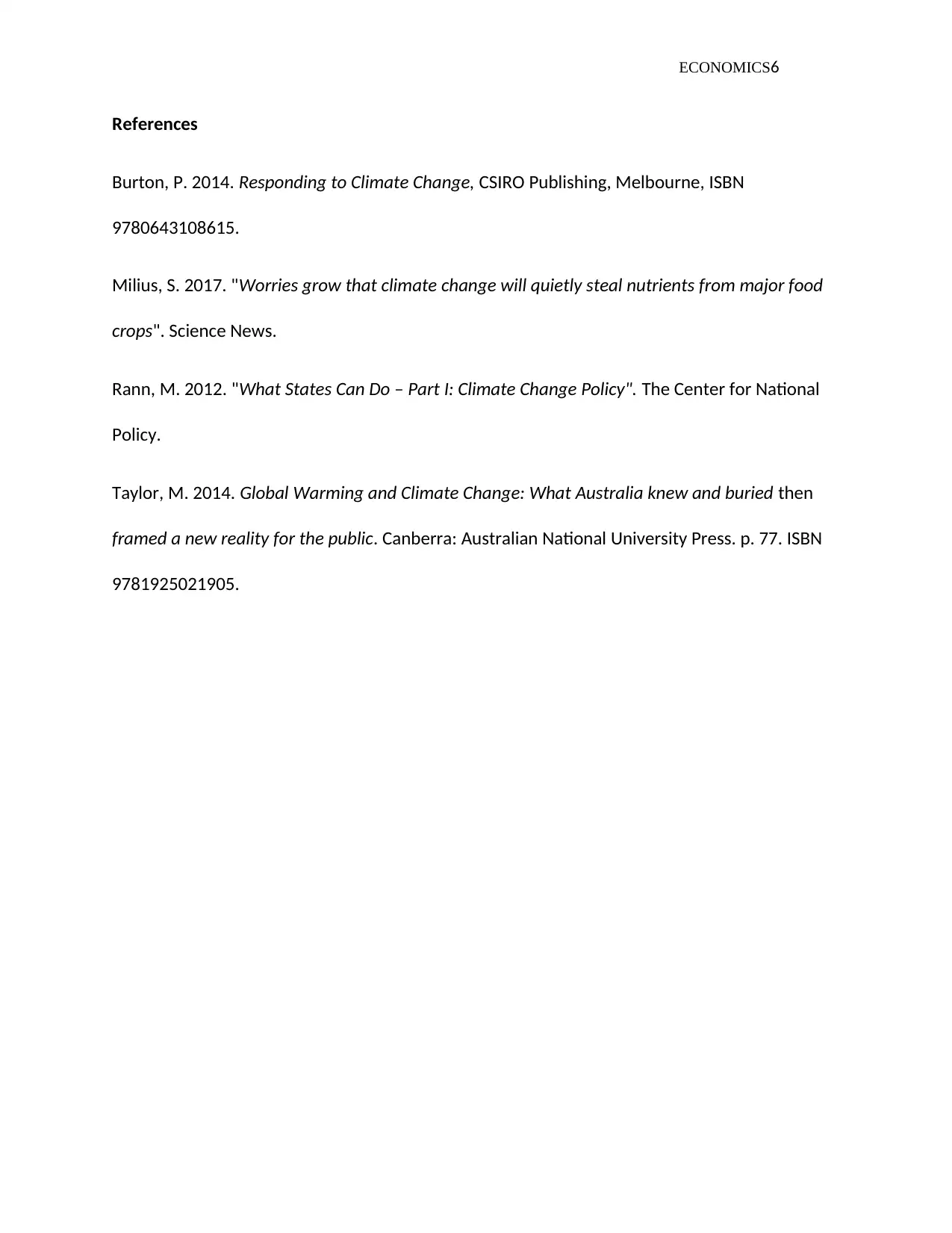
ECONOMICS6
References
Burton, P. 2014. Responding to Climate Change, CSIRO Publishing, Melbourne, ISBN
9780643108615.
Milius, S. 2017. "Worries grow that climate change will quietly steal nutrients from major food
crops". Science News.
Rann, M. 2012. "What States Can Do – Part I: Climate Change Policy". The Center for National
Policy.
Taylor, M. 2014. Global Warming and Climate Change: What Australia knew and buried then
framed a new reality for the public. Canberra: Australian National University Press. p. 77. ISBN
9781925021905.
References
Burton, P. 2014. Responding to Climate Change, CSIRO Publishing, Melbourne, ISBN
9780643108615.
Milius, S. 2017. "Worries grow that climate change will quietly steal nutrients from major food
crops". Science News.
Rann, M. 2012. "What States Can Do – Part I: Climate Change Policy". The Center for National
Policy.
Taylor, M. 2014. Global Warming and Climate Change: What Australia knew and buried then
framed a new reality for the public. Canberra: Australian National University Press. p. 77. ISBN
9781925021905.
⊘ This is a preview!⊘
Do you want full access?
Subscribe today to unlock all pages.

Trusted by 1+ million students worldwide
1 out of 6
Related Documents
Your All-in-One AI-Powered Toolkit for Academic Success.
+13062052269
info@desklib.com
Available 24*7 on WhatsApp / Email
![[object Object]](/_next/static/media/star-bottom.7253800d.svg)
Unlock your academic potential
Copyright © 2020–2025 A2Z Services. All Rights Reserved. Developed and managed by ZUCOL.




